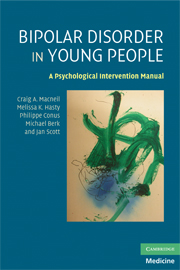Book contents
- Frontmatter
- Contents
- Preface
- Acknowledgements
- Introduction
- 1 Bipolar disorder
- 2 Assessment and engagement
- 3 Insight, adaptation, and functional recovery
- 4 Medication adherence
- 5 Cognitive behavioral therapy interventions
- 6 Social rhythm regulation
- 7 Relationship issues and family work
- 8 Alcohol, substance abuse, and other comorbid disorders
- 9 Identifying early warning signs, preventing relapse, and termination of therapy
- Appendices
- References
- Index
1 - Bipolar disorder
Published online by Cambridge University Press: 06 July 2010
- Frontmatter
- Contents
- Preface
- Acknowledgements
- Introduction
- 1 Bipolar disorder
- 2 Assessment and engagement
- 3 Insight, adaptation, and functional recovery
- 4 Medication adherence
- 5 Cognitive behavioral therapy interventions
- 6 Social rhythm regulation
- 7 Relationship issues and family work
- 8 Alcohol, substance abuse, and other comorbid disorders
- 9 Identifying early warning signs, preventing relapse, and termination of therapy
- Appendices
- References
- Index
Summary
Moods are so essential to our navigating the world that when they go awry it is only a matter of time until distress and disaster hit. Moods allow us to gauge people and circumstance, alert us to danger and opportunity, and provide us with the means to convey our emotional and physical state to others.
Jamison (2003, p. xv)Bipolar disorder, also known as manic depression, is a mood disorder that can involve extreme changes in affect, cognition, and behavior. In its extreme form, bipolar disorder can be associated with psychotic symptoms and can require inpatient admission due to disorganization and impulsivity in the manic phase, or due to suicidal ideation or neglect of self-care in the depressive phase. It affects males and females in equal numbers, and has similar rates across all socio-economic groups. Its onset generally occurs during late adolescence or early adulthood, with this having significant implications for the person's developmental trajectory and quality of life. This will be described later in the chapter.
While the Diagnostic and Statistical Manual of Mental Disorders: Fourth Edition – Text Revision (DSM-IV-TR) (American Psychiatric Association, 2000) should be consulted regarding diagnosis, a brief summary is as follows:
A major depressive episode is diagnosed through the presence of depressed mood or loss of interest or pleasure for most of the day, nearly every day for two weeks or more. It must also be accompanied by five or more from nine symptoms, including feelings of worthlessness or guilt, insomnia or hypersomnia, psychomotor agitation or retardation, and fatigue.
[…]
- Type
- Chapter
- Information
- Bipolar Disorder in Young PeopleA Psychological Intervention Manual, pp. 1 - 20Publisher: Cambridge University PressPrint publication year: 2009



